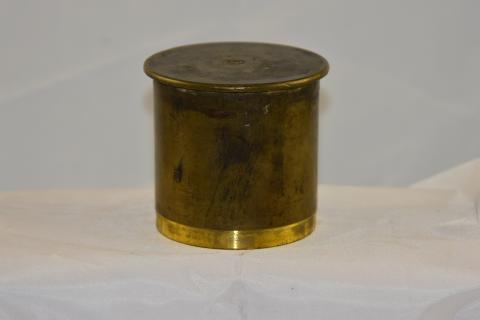This is a piece of trench art that was used by combining the bases of two different artillery shells to form a container. The larger of the shells, which is 3.5" (8.9cm) in height serves as the base of the container and sports a filed metal ring around the top for the accompanying cap to fit over. This portion of the piece is crafted from a German 7.7cm feldkanone 96 shell casing. It features no discernable engravings or decorations on its sides, and no distinctive features on its interior. The interior surface of the shell has been worn down and polished, indicating a degree of competent metalworking post-manufacture. The legible inscriptions on the bottom of the casing indicate that the shell was made by the Otto Eberhardt Patronenfabrik company, which was established in 1860 and served the German government as a munitions manufacturer throughout the First World War. The date is engraved as June 1915. The letters, "Ke" are inscribed underneath a decorative crown symbol. The inscription "St 154" can be found above the Patronenfabrik label. Trench art was a form of art that was produced using spent shells and other used items from the trenches of World War One. Many of the countries that participated in the war produced pieces of art crafted out of spent munitions, particularly Turkish and Chinese participants. Pieces of trench art were not only decorative, however; they could be utilized in a variety of ways for a variety of practical purposes, such as ash trays, tobacco containers, rings, and even lighters. This content can be used with the following resources: SS.3.28: Cultural Contributions SS-WH.9-12.26: Iowans Influence World History This content can be used to educate students on the ways in which the First World War inspired new arts and culture and how that inspiration was influenced by the service of Iowan soldiers during the war. For any use other than instructional resources, please check with the organization that owns this item for any copyright restrictions.
2018.002.031 [Artwork]
Legal Status
Copyright to this resource is held by the Iowa Masonic Library and Museum and has been provided here for educational purposes only, specifically for use in the Iowa Museum Association's "Teaching Iowa History" project. It may not be downloaded, reproduced or distributed in any format without written permission from the Rights Holder. For more information on U.S. and International copyright laws, consult an attorney.

